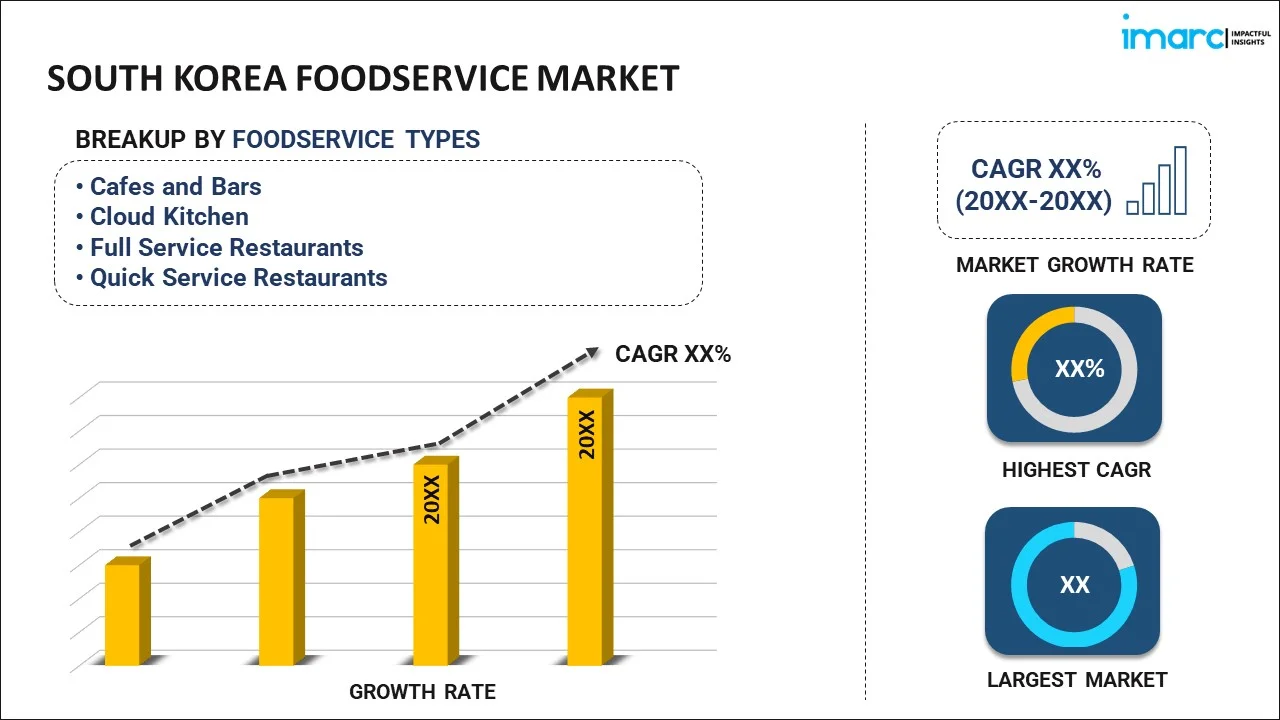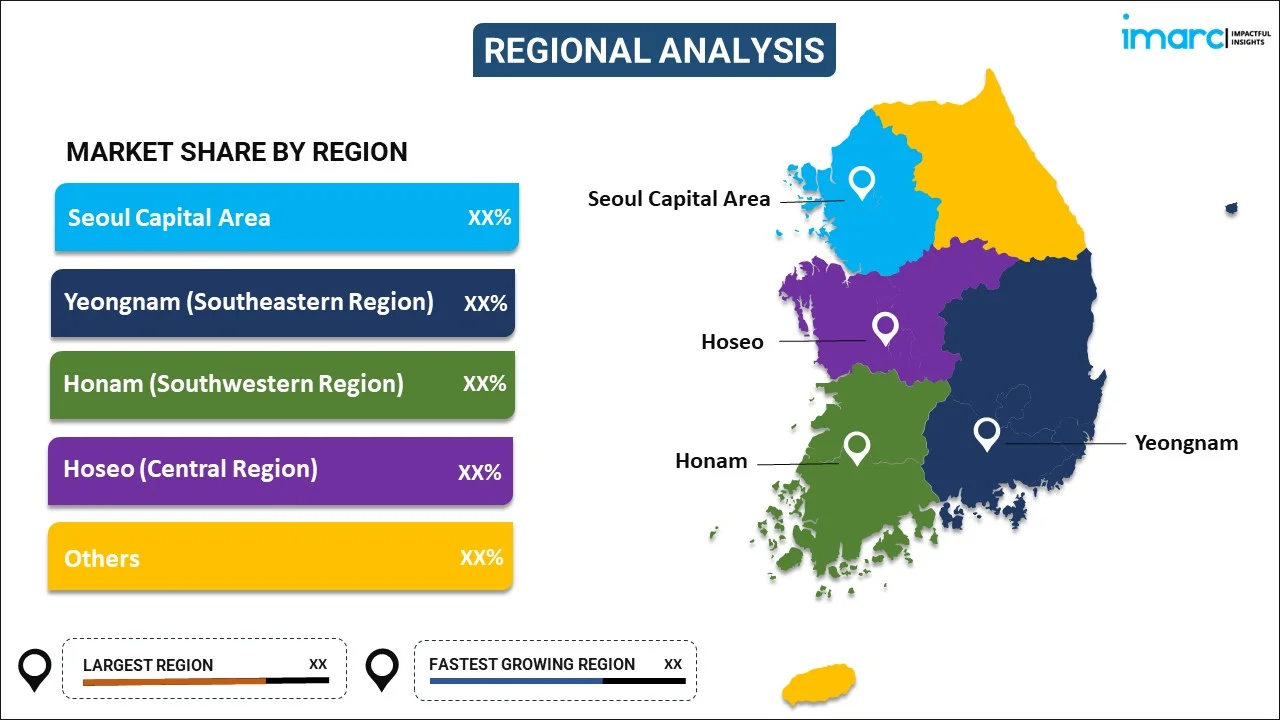
South Korea Foodservice Market Report by Foodservice Type (Cafes and Bars, Cloud Kitchen, Full Service Restaurants, Quick Service Restaurants), Outlet (Chained Outlets, Independent Outlets), Location (Leisure, Lodging, Retail, Standalone, Travel), and Region 2024-2032
Market Overview:
South Korea foodservice market size is projected to exhibit a growth rate (CAGR) of 18.80% during 2024-2032. The changing consumer preferences and shifting dietary patterns, continual expansion of tourism and hospitality industries and the proliferation of creative, and unique food concepts, such as themed cafes and fusion cuisine represent some of the key factors driving the market.
|
Report Attribute
|
Key Statistics
|
|---|---|
|
Base Year
|
2023 |
|
Forecast Years
|
2024-2032
|
|
Historical Years
|
2018-2023
|
| Market Growth Rate (2024-2032) | 18.80% |
Foodservice is a critical sector within the hospitality and culinary industry, encompassing a wide range of businesses that prepare, serve, and distribute food and beverages to consumers. It plays an integral role in meeting the diverse dining needs of individuals and communities, ranging from quick-service restaurants to fine dining establishments, catering services, and institutional food providers. Foodservice businesses can include restaurants, cafeterias, food trucks, and catering companies. Some of the integral components of food service include food preparation, menu planning, service delivery, customer experience and supply chain management that aimed at providing a positive dining experience to customers. Additionally, foodservice businesses can be categorized into various types, each with its own unique characteristics and target audience, including restaurants, cafeterias, food trucks, catering services, coffee shops, institutional foodservice and quick service and fast food.
South Korea Foodservice Market Trends:
The market is primarily driven by the changing consumer preferences and shifting dietary patterns. This can be attributed to the growing number of individuals seeking diverse and international cuisines, healthier options, and unique dining experiences. This has led to a proliferation of restaurants and foodservice establishments catering to various tastes and dietary preferences. Moreover, the rise of food delivery apps and services has transformed the South Korean foodservice landscape. Consumers can now order a wide variety of dishes from the comfort of their homes or workplaces. This convenience-driven trend has led to increased sales for restaurants and expanded the market's reach, thereby propelling the industry. Along with this, continual advancements in technology are playing a significant role in the market. Restaurants are adopting digital solutions for order management, payment processing, and customer engagement, which is acting as a growth-inducing factor. Moreover, technology-driven data analytics are helping businesses understand customer behavior and tailor their offerings accordingly, further impacting the market. Additionally, continual expansion of tourism and hospitality industries are creating a positive market outlook. Also, several government policies and initiatives have influenced the foodservice sector positively. Additionally, regulatory support and incentives for small and medium-sized restaurants have encouraged entrepreneurship and innovation in the industry, thereby impacting the overall market. In addition, entrepreneurship and culinary innovation are emerging in the country. Creative and unique food concepts, such as themed cafes, fusion cuisine, and experiential dining, have gained popularity, attracting both local and international customers, acting as other growth-inducing factors. Other factors, including rapid urbanization, inflating disposable income levels of the masses and increasing focus on food safety and quality assurance, are also positively influencing the market.
South Korea Foodservice Market Segmentation:
IMARC Group provides an analysis of the key trends in each segment of the market, along with forecasts at the country level for 2024-2032. Our report has categorized the market based on foodservice type, outlet, and location.
Foodservice Type Insights:

- Cafes and Bars
- Bars and Pubs
- Cafes
- Juice/Smoothie/Desserts Bars
- Specialist Coffee and Tea Shops
- Cloud Kitchen
- Full Service Restaurants
- Asian
- European
- Latin American
- Middle Eastern
- North American
- Others
- Quick Service Restaurants
- Bakeries
- Burger
- Ice Cream
- Meat-based Cuisines
- Pizza
- Others
The report has provided a detailed breakup and analysis of the market based on the foodservice type. This includes cafes and bars (bars and pubs, cafes, juice/smoothie/desserts bars, specialist coffee and tea shops), cloud kitchen, full service restaurants (Asian, European, Latin American, Middle Eastern, North American, and others), and quick service restaurants (bakeries, burger, ice cream, meat-based cuisines, pizza, and others).
Outlet Insights:
- Chained Outlets
- Independent Outlets
A detailed breakup and analysis of the market based on the outlet have also been provided in the report. This includes chained outlets and independent outlets.
Location Insights:
- Leisure
- Lodging
- Retail
- Standalone
- Travel
The report has provided a detailed breakup and analysis of the market based on the location. This includes leisure, lodging, retail, standalone, and travel.
Regional Insights:

- Seoul Capital Area
- Yeongnam (Southeastern Region)
- Honam (Southwestern Region)
- Hoseo (Central Region)
- Others
The report has also provided a comprehensive analysis of all the major regional markets, which include Seoul Capital Area, Yeongnam (Southeastern Region), Honam (Southwestern Region), Hoseo (Central Region), and others.
Competitive Landscape:
The market research report has also provided a comprehensive analysis of the competitive landscape in the market. Competitive analysis such as market structure, key player positioning, top winning strategies, competitive dashboard, and company evaluation quadrant has been covered in the report. Also, detailed profiles of all major companies have been provided. Some of the key players include:
- CJ Foodville Corporation
- Inspire Brands Inc.
- HanGook McDonald’s Co. Ltd.
- Mom's Touch & Co.
- Starbucks Coffee Korea Co., Ltd. (Starbucks Corporation)
(Please note that this is only a partial list of the key players, and the complete list is provided in the report.)
South Korea Foodservice Market Report Coverage:
| Report Features | Details |
|---|---|
| Base Year of the Analysis | 2023 |
| Historical Period | 2018-2023 |
| Forecast Period | 2024-2032 |
| Units | US$ Million |
| Scope of the Report | Exploration of Historical and Forecast Trends, Industry Catalysts and Challenges, Segment-Wise Historical and Predictive Market Assessment:
|
| Foodservice Types Covered |
|
| Outlets Covered | Chained Outlets, Independent Outlets |
| Locations Covered | Leisure, Lodging, Retail, Standalone, Travel |
| Regions Covered | Seoul Capital Area, Yeongnam (Southeastern Region), Honam (Southwestern Region), Hoseo (Central Region), Others |
| Companies Covered | CJ Foodville Corporation, Inspire Brands Inc., HanGook McDonald’s Co. Ltd., Mom's Touch & Co., Starbucks Coffee Korea Co., Ltd. (Starbucks Corporation), etc. (Please note that this is only a partial list of the key players, and the complete list is provided in the report.) |
| Customization Scope | 10% Free Customization |
| Report Price and Purchase Option | Single User License: US$ 3699 Five User License: US$ 4699 Corporate License: US$ 5699 |
| Post-Sale Analyst Support | 10-12 Weeks |
| Delivery Format | PDF and Excel through Email (We can also provide the editable version of the report in PPT/Word format on special request) |
Key Questions Answered in This Report:
- How has the South Korea foodservice market performed so far and how will it perform in the coming years?
- What has been the impact of COVID-19 on the South Korea foodservice market?
- What is the breakup of the South Korea foodservice market on the basis of foodservice type?
- What is the breakup of the South Korea foodservice market on the basis of outlet?
- What is the breakup of the South Korea foodservice market on the basis of location?
- What are the various stages in the value chain of the South Korea foodservice market?
- What are the key driving factors and challenges in the South Korea foodservice market?
- What is the structure of the South Korea foodservice market and who are the key players?
- What is the degree of competition in the South Korea foodservice market?
Key Benefits for Stakeholders:
- IMARC’s industry report offers a comprehensive quantitative analysis of various market segments, historical and current market trends, market forecasts, and dynamics of the South Korea foodservice market from 2018-2032.
- The research report provides the latest information on the market drivers, challenges, and opportunities in the South Korea foodservice market.
- Porter's five forces analysis assist stakeholders in assessing the impact of new entrants, competitive rivalry, supplier power, buyer power, and the threat of substitution. It helps stakeholders to analyze the level of competition within the South Korea foodservice industry and its attractiveness.
- Competitive landscape allows stakeholders to understand their competitive environment and provides an insight into the current positions of key players in the market.
Need more help?
- Speak to our experienced analysts for insights on the current market scenarios.
- Include additional segments and countries to customize the report as per your requirement.
- Gain an unparalleled competitive advantage in your domain by understanding how to utilize the report and positively impacting your operations and revenue.
- For further assistance, please connect with our analysts.
 Request Customization
Request Customization
 Speak to an Analyst
Speak to an Analyst
 Request Brochure
Request Brochure
 Inquire Before Buying
Inquire Before Buying




.webp)




.webp)












